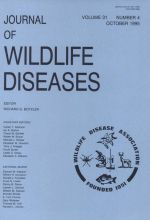We validated fecal metabolite analysis as a noninvasive means of diagnosing pregnancy in uncaptured, free-ranging Rocky Mountain elk (Cervus elaphus nelsoni). During November 1991, we collected blood samples from 21 radiocollared, 1- to 10-year-old female elk in Yellowstone National Park, Wyoming (USA), and determined their pregnancy status by radioimmunoassay of serum pregnancy specific protein B and serum progesterone concentrations. From December 1991 through April 1992, we collected three to 12 fecal samples from each collared elk and measured the concentration of estrone conjugates, pregnanediol-3-glucuronide, and free progesterone by enzyme immunoassays. We also evaluated fecal samples from 10 unmarked male and eight calf elk. Pregnant females had significantly (P < 0.001) higher concentrations of all three fecal metabolites than nonpregnant animals, especially later in gestation (March to April). We developed all possible combinations of univariate, bivariate, and multivariate discriminant function analysis models to determine those variables most useful in predicting memberships of pregnant versus nonpregnant elk during the March to April time-period. We validated each model by applying the classification functions to 11 pregnant and eight nonpregnant elk that were not included in the development of the original models. Accuracy of the discriminant function analysis models ranged from 57 to 84%, with the univariate model based on pregnanediol-3-glucuronide concentration providing the highest classification. Fecal metabolite analysis will enable biologists to noninvasively assess the pregnancy status of elk, especially when diagnoses are based upon multiple samples collected between mid-March and mid-April.
How to translate text using browser tools
1 October 1995
DIAGNOSING PREGNANCY IN FREE-RANGING ELK USING FECAL STEROID METABOLITES
P. J. White,
Robert A. Garrott,
Jay F. Kirkpatrick,
Elizabeth V. Berkeley

Journal of Wildlife Diseases
Vol. 31 • No. 4
October 1995
Vol. 31 • No. 4
October 1995
Cervus elaphus
elk
enzyme immunoassays
feces
pregnancy
reproduction
steroids




